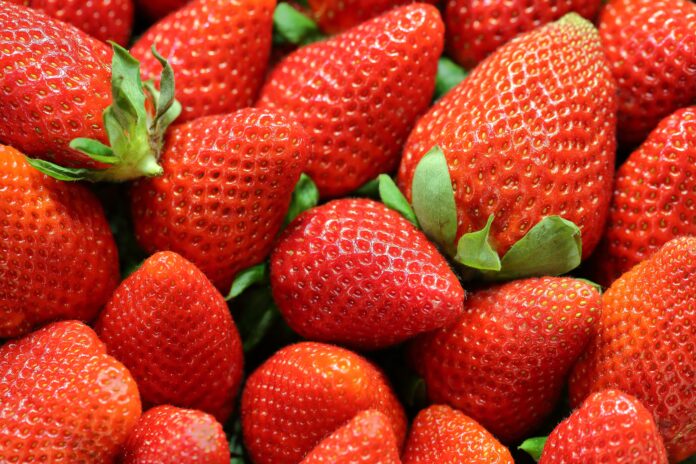Fresh strawberries are a common and enticing sight in supermarkets in late spring and summer. Rows of punnets of strawberries are on sale as you enter most food stores or displayed in a prominent spot in the fruit and vegetable sections. They are like nature’s eye candy and difficult to walk on by without putting a punnet (or two) in your shopping trolley.
Of all Dutch grown fruit and vegetables, the most pesticide residues can be found on strawberries. This was the finding in a 2016 study done by the Dutch Food and consumer safety authority or NVWA which examined fruits and vegetables for pesticide residues. Out of 39 samples of Dutch strawberries, the researchers found, on average, 7 different chemical pesticide residues per sample and alarmingly seventeen residues on one sample.
Why do Dutch growers use so many pesticides?
Have you ever seen a wild strawberry? They are vastly smaller and less showy than their modern counterpart. The modern strawberry is a human-made hybrid crop and does not survive long in a wild setting. They have been bred for colour, taste, firmness and shelf life. This tampering with nature weakens the strawberry plant’s resistance and forces growers to use chemical pesticides to repel fungi and insects. As pests become more resistant more chemical agents are needed to ensure crops make it to the supermarket shelves in an attractive and edible form.
So what is the big fuss about consuming pesticide residues?
Pesticides have both unintended human health effects (especially on children) and environmental health effects on pollinators (especially bees). Many are not officially listed for negative health effects because the research has not been done or there is not enough evidence yet to support making official claims. However, there is mounting anecdotal evidence and some legal precedent (including the Roundup™ court case) to suggest the following effects of many chemical pesticides used in agriculture (including strawberries) and horticulture:
- Carcinogenic (or cancer-causing)
- Hormone disruption (involved with reproductive, development and fertility problems)
- Neurotoxic (or toxic to the nervous system)
The problem is not only single pesticide use per se. Of further concern are also the combined effects when multiple pesticides are used. They make for a potentially unhealthy cocktail, of which the long-term combination effects on humans and our environment are not known. Sadly this aspect seems to be largely ignored by farmers and lawmakers.
The Pesticide Action Network or PAN Europe coordinates independent food testing initiatives designed to inform consumers about the levels of pesticides in foods. PAN Europe has repeatedly pressed regulators to consider, in their food safety evaluation, this untested ‘combination effect’ where combined toxic effects may, in fact, be magnified and more harmful to the environment, ecosystem and human health than expected.
“It’s insane that pesticide-contaminated food has become the norm” adds Angeliki Lysimachou, the environmental toxicologist of PAN Europe “…regulators must act responsibly and put an end to these daily pesticide exposures. If not for the sake of ourselves, then for the sake of our children.”
These findings are not unique to The Netherlands and mirror similar findings by the Environmental Working Group or EWG in the United States. The EWG publishes an annual list for consumers on the most sprayed produce called the dirty dozen. Strawberries appear at the top of the list as the ‘dirtiest’ and most pesticide-laden of all!
Here is the 2021 EWG ‘Dirty Dozen’ most pesticide-laden produce:
- Strawberries
- Spinach
- Kale/Collard/Mustard greens
- Nectarines
- Apples
- Grapes
- Cherries
- Peaches
- Pears
- Bell and hot peppers
- Celery
- Tomatoes
What do apples, pears, cherries and strawberries all have in common?
They are all on the EWG’s dirty dozen list and in The Netherlands, they are still sprayed with two pesticides known for their health and safety concerns. According to Foodwatch, five pesticides were exposed as problematic in 2015. Two of these products may still be used in the Netherlands until the middle of 2022 in the cultivation of apples, pears, cherries and strawberries. The Dutch government previously expressed the ambition for local farmers and horticulturists to use the fewest pesticides in Europe, and for both agriculture and horticulture to be ‘chemical-free’ by 2030. Let’s hold thumbs…!
Can you wash off the pesticide residues?
No. Even rinsing them well doesn’t remove the pesticides that have penetrated the peel and deep into the produce. A study did however show that surface pesticide residues on apples were most effectively removed by sodium bicarbonate (baking soda or NaHCO3) solution when compared to either tap water or Clorox bleach. Peeling is more effective to remove the penetrated pesticides; however, the nutrients and bioactive compounds in the peels will be sacrificed.
Here are some take-home points to help you avoid high exposures to pesticide residues on strawberries and other commercially farmed ‘dirty’ produce like apples, pears and cherries:
- Buy organic produce especially of those on the dirty dozen list
- Grow your own at home or in an allotment
- Wash commercially grown produce in a baking soda solution
- Choose to eat imperfect, wild and heritage plant varieties where available
- Read my earlier article on Going Organic
Moms and Dads, please think twice about feeding your young children a diet rich in commercially farmed strawberries this summer. Their health and wellbeing are most vulnerable to the effects of pesticide residues together with other small creatures like our friends the bees!
For Eindhoven News: Nicole Cullinan, Functional Medicine Homeopath and creator of Wellness Place International
















